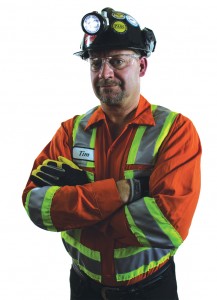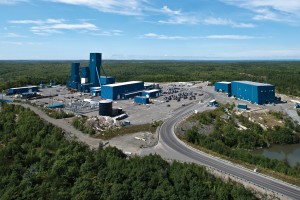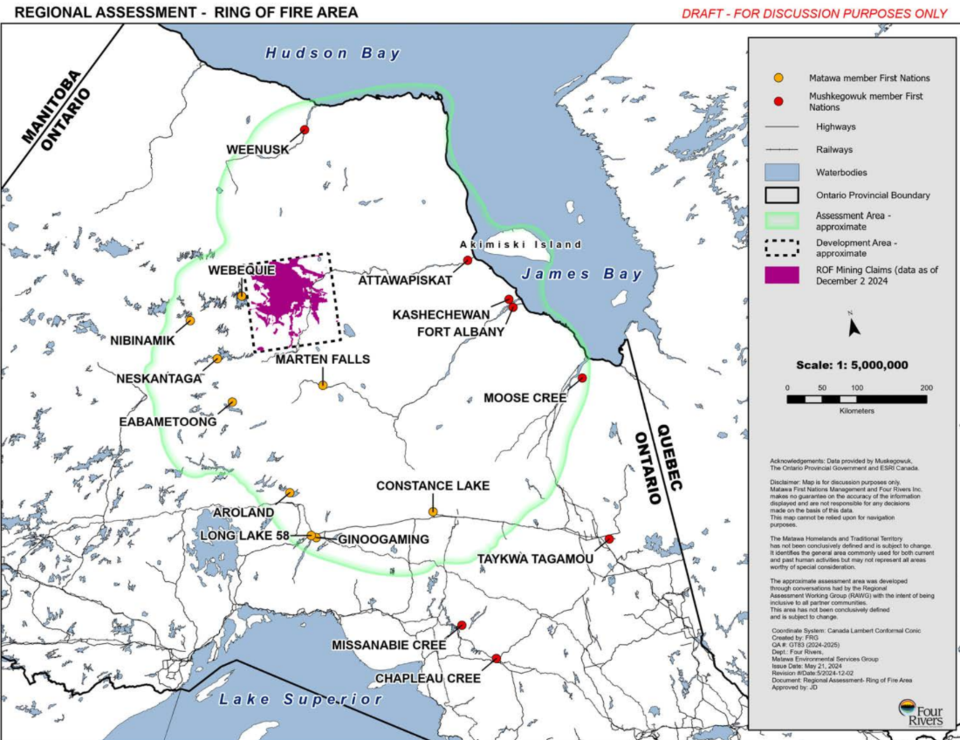Underground maintenance at Glencore’s Nickel Rim South mine gets five-star rating

A close look ata the maintenance area at the Nickel Rim South mine showing drive-on ramps and built-in service pits.
It’s conventional wisdom that underground mining is a dirty business. In fact, it’s undeniably true because as almost everybody knows, the nature of working underground involves spaces that are often cramped, damp and dark.
To say that the environment is ‘challenging’ is an understatement at best, and because of these conditions, underground maintenance and repair shops often are not held to the same standards as surface mines.
But contrary to this perception is Glencore’s Nickel Rim South mine in Sudbury where things have changed thanks to the company’s decision to build a world-class maintenance shop underground by following best practices for safety, and contamination.
And, as a result of its efforts to create a first-class repair shop 1480m below the surface, Glencore earned the first Caterpillar Certified Five-Star Contamination Control designation for an underground maintenance facility.
Taking on a Challenge
During an earlier Caterpillar-sponsored mining forum event, participants were challenged to take away one thing from the sessions that they could implement at their site.
Tim Hinds, Nickel Rim South’s maintenance general foreman, was in attendance and he says he chose contamination control because the topic was still on the top of his mind when Nickel Rim South mine was in the early stages of developing a new $(U.S.) 10.3-million underground maintenance shop.
To assist in the implementation process, Caterpillar contamination control market professional Ron Meischner visited the mine to evaluate the workflow and contamination control compliance of the new facility.
During the visit, he was asked by Stu Greaves, the mine’s representative from Cat dealer Toromont, to give a presentation on contamination control to some of the site’s key management personnel.
“When I completed my presentation, I was approached by Tim, who asked if I would support him if he decided to implement a contamination control program,” recalls Meischner. “My response was, ‘Toromont and Caterpillar are your first line of support, and my job is to support them — so yes, I will!’ ”
Hinds requested Meischner return a month later to perform a baseline assessment and to provide guidance on the prioritization of continuous improvement projects. “The mine team was excellent to work with and very proficient at project management,” says Meischner, who continued to support the site along with Susan Gaugush, a Caterpillar service technical representative.
“We showed Tim how a proactive contamination control program could lower their operating costs, and we brought metrics to prove it,” says Meischner. “He brought in other people on the team and began to build collaboration and a commitment to making contamination control part of the culture.”
“We pointed out the fact that Glencore already had the first five-star surface mine with its Alumbrera mine in Argentina,” continued Meischner. “And we said, ‘Wouldn’t it be great if they also had the first underground one?’
Tim jumped on board, and said, “Here we are.”
Supporting an Underground Operation
Nickel Rim South is the largest mine in Glencore’s Sudbury Integrated Nickel Operations, which has been mining in the area since 1929. The mine is located in a 60km-wide geological formation in the Sudbury basin. In addition to Nickel Rim South, the operations also include; Fraser Mine, Strathcona Mill, and Sudbury Smelter. The site primarily produces nickel and copper, with some gold, silver, platinum, palladium and cobalt also produced.
The Sudbury operations employ about 1,300 permanent workers.
Ore was discovered at the site between 1100m and 1700m in 2001, with construction of Nickel Rim South starting in 2006, and operational at full capacity since October 2010. The mine produces about 1.25 million tonnes (1.38 million tons) per year. Nickel Rim South is a blasthole mine, allowing the site to take advantage of gravity and a minimum amount of hauling. The mine drills 30-m panels and handles the ore with scoops.
Production equipment includes 10 Cat R1700G underground loaders, one Cat AD30 underground articulated truck, three 420F backhoe loaders, a 120M motor grader, and three TH40 telehandlers.
On the surface, operations are supported by an IT38G integrated tool carrier and a V300B forklift.
Originally the mine operated with three captive levels, which made it necessary to have maintenance shops on each level. Each shop was about 5m high and 5 m wide; a tight fit for a Cat R1700.
“We had one foreman for all three levels, which was a little difficult,” recalls Hinds. “We couldn’t share equipment and it was an effort to move people.”
New shops were built in 2008, but they were still located on different levels and were far from ideal. But Hinds looked at the challenges as a learning opportunity for the next step. “We learned quite a bit during those days about how we could make improvements and what we ultimately wanted our shop to be,” he says. “We listened to the trades people and listened to our people to see how we could get a better shop. We came up with a vision of what we wanted that shop to be, and how it could improve our operation.”
Taking Maintenance to a New Level
In 2010, the Nickel Rim South team shared its vision for a new maintenance shop with its corporate owners, asking for $(U.S.)10.3 million to make it happen. That vision was broken down into five key focus areas:
- Safety. A more ergonomic shop design, combined with a larger workspace and storage areas to improve housekeeping, would make working conditions safer for everyone on site.
- Quality and reliability. A new shop would improve maintenance across the board — extending the lifespan of equipment, minimizing the cost per hour of the equipment fleet, and enabling a more comprehensive component replacement program.
- Revenue opportunity. Improved maintenance leads to equipment that runs better and lasts longer. A decrease in Mean Time to Repair and fewer breakdowns make equipment more available and could make it possible to reduce the size of the fleet required to run the operation.
- Materials savings. When maintenance is proactive and components are replaced in a timely manner, fewer parts and components must be kept on hand in case of an emergency repair. In addition, managing inventory of parts and tools in a centralized facility leads to improved efficiencies.
- Labour productivity improvements. Providing a centralized space for maintenance employees, with active supervision, would create synergies and build a unified, focused team.
In addition, the new space would allow the mine to do more work on its own equipment rather than contract it out.
“In order to get the funding for the new shop, we had to work hard to ensure that we achieve the high standards in all of our focus areas,” says Hinds. “And I have to say, we’ve achieved our target and are able to showcase every one of them.”
Taking Control of Contaminants
Nickel Rim supports its underground mining equipment in partnership with local Cat dealer Toromont. BothToromont and Caterpillar were key advisors to the maintenance team during the planning and construction of the new shop.
“We went through many phases during the development,” says Hinds. “We met with our mechanics and got their input. We talked to trades people. We went to Toromont’s rebuild shop to see how they are organized. We got a lot of best practices from watching how they work.”
Hinds had long taken advantage of the expertise of Caterpillar and Toromont. In 2010, he attended a Caterpillar mining forum event during which he first began to think about contamination control and how he could implement some of these best practices into Nickel Rim South.
“We decided that we didn’t want to run our facility like we had been, and like many other underground sites traditionally do,” he says. When Caterpillar’s Meischner visited the site, his initial analysis led to a two-and-a-half year project to advance the cause of contamination control.
After the initial assessment, Glencore took on the challenge to achieve Caterpillar five-star status — a challenge that would take the mine from a base score of 23 per cent compliance to the required 95 per cent.
“Nickel Rim South took ownership of the project,” Meischner says. “The mine assembled a team, developed the action items and made the commitment.”
“They advanced their shop in a sustainable way,” Meischner continues. “You can’t sustain something this monumental if you try to do it all in just a few months. We looked at every aspect of the process as a continuous improvement project.”
Incorporating Contamination Control Into Design
Because Nickel Rim South was in the process of building an entirely new maintenance shop, the mine was in the perfect position to design a facility ideally suited to control contamination.
Ventilation was a key consideration, making the air safer for underground workers, but also reducing dust that is a leading contributor to contamination. Air is forced in and out of the shop and the space is designed for ventilation flow. This eliminates the need to purchase expensive electricity to power fans.
The entire area is designed with a one-way system of travel. A staging area helps with traffic flow into the maintenance area, which also keeps the environment safer for those working in the shop.
A wash bay is located just outside the shop, and all equipment must be washed before it comes in for maintenance.
The shop itself is ergonomically designed to make maintenance tasks easier on the technicians. The area includes three individual ramps and a crane that hangs from the back of the shop to keep the floor area clean. Work benches were eliminated from the new shop.
“Work benches tend to get cluttery and things pile up underneath them and they just become a mess,” says Hinds.
Hand tools are stored in a specially designed area, eliminating the need for each individual mechanic to have his own tool box.
“Tool boxes usually sit up against the wall, and that means there’s dirt underneath,” says Hinds. “In addition, we have 44 mechanics down there, which would mean 44 tool boxes. That takes up a lot of space. So we buy the tools, and even though we’re spending money on them, we save that tenfold by not developing that extra landscape underground.”
A reference library contains maintenance manuals and computers so the mechanics can make up work orders and order parts. The parts department and warehouse are nearby, but are kept locked to keep them clean and organized.
Starting with Some Quick Wins
The mine’s road to the five-star achievement started with some simple changes well before construction of the new maintenance shop was under way.
“They had to go back to basics,” says Meischner. “Sometimes it’s just as simple as making sure the right oil goes in the right hole at the right time. You have to pay attention to the basics before the bells and whistles will do you any good.”
Hinds agrees. “At the same time we were incorporating contamination control into the design of our new shop, we went after the low-hanging fruit and made some changes.” These sometimes-easy fixes are based on best practices and can be implemented quickly and for minimal cost.
Eliminating oil-absorbing granular material
When visiting Toromont’s rebuild facility, Hinds noticed that the shop didn’t rely on “floor dry” to absorb spills on the shop floor.
“At Nickel Rim South, the crew would bust a bag open, spill it on the floor, scatter dust everywhere. They’re breathing it in,” he says. “Then we don’t always clean it up right away so we end up shuffling it around. The next day you clean up half of it, and the other half gets kicked around under the tool boxes and the benches, the scoops run over it, creepers are catching in it and it’s embedded in the floor.”
The mine purchased some environmentally friendly absorbent pads, got some mops and pails for cleaning, and gave it a trial. The use quickly spread to other levels.
Taking Care of Fluids
Nickel Rim South buys the best oil possible for use in its equipment, but that doesn’t guarantee cleanliness. By putting dessicant filters on barrels and bulk tanks, sealing them, adding a kidney loop system and doing particulate counts before refilling the tanks, the site has made great strides in protecting components from the dangers of contaminated oil.
“We continuously clean,” says Hinds. “It’s working out great.” In addition, the maintenance department installed a kidney- loop system on the hydraulic system of electric-powered machines to eliminate the dust and contamination that are continually being pulled in.
The mine has two portable kidney looping units for use across the fleet.
“This has been extremely successful for us,” says Hinds.
Protecting Hoses
In addition to building an ergonomic hose rack, the maintenance team found they could keep hoses cleaner by using re-sealable plastic bags to cover hose ends, eliminating the need to shuffle through a pile of contaminated plugs of different sizes in search of one that fit.
“These are just pennies a piece,” says Hinds. “And they make a huge difference.”
Protecting New Parts
In addition to working with OEMs to help ensure parts and components arrive properly packaged, Nickel Rim South now bags and seals every product that doesn’t come in an appropriate container.
“Parts are expensive. We try to protect our investment,” says Hinds. “We don’t keep anything in open bins. We have drawer systems, plus the second layer of protection in a re-sealable bag or the original packaging.”
In addition, the mine invested in an inexpensive backpack vacuum that is used to pick up the dust in the parts area that is not captured by the ventilation and pressurization system.
“We’ve got millions of dollars invested in parts, and when I go to use them, I want them to last. This small investment makes a world of difference in keeping the area clean.”
Keeping Fuel Clean
Hinds admits that Nickel Rim South had a lot to learn when it comes to clean fuel. “Our breathing systems were open to the atmosphere,” he says. “Every time we sent the fuel down into the mine, there was a risk that we were contaminating what we were buying.”
The mine invested in dessicant breathers and added weighted explosion discs to keep the fuel covered. “This stuff is cheap, but it was stuff that we missed,” he says.
Leveraging Technology
Working with Toromont, Nickel Rim South uses a scheduled oil sample program (S.O.S.S.M) on all equipment, down to the smallest machines. The system allows for real-time auditing, measuring 30 different parameters and sending emails to keep the maintenance team informed of oil pressures, temperatures, idle time and more.
“We don’t have to rely on the operator to tell us if a machine is having a problem because now we know it too,” says Hinds.
Changing a Culture
Hinds and the Caterpillar experts are quick to point out that while making contamination control a priority may seem obvious, changing the way things are done at a mine site is not an easy task.
The achievement of five-star status required training, good communication, continued reinforcement, regular assessment, and the buy-in of everyone involved. Even now, it takes constant reminders to make the effort sustainable.
“This was tough to do, and it’s a never-ending battle,” says Hinds.
Communication is key to Nickel Rim South mine’s success, and in addition to telling the team what is expected of them, it’s important to listen to what they have to offer.
“There are a lot of good ideas out there,” says Hinds. “Knocking down the low-hanging ideas created an environment of trust and engagement, inspired creativity among the workforce, and allowed change to be embraced instead of resisted.”
Operator buy-in is especially important. “It takes a while to prove that there is a better way,” Hinds says. “We explained what contamination control was and how it could help. We shared the results, like reductions in downtime and the availability of equipment. Then they started looking at the things we were doing and watching those results.”
Hinds and his team shared ideas with the operators on what they can do to help with the contamination control effort. “We gave them examples, like wipe off the nozzle before you top off your engine oil, wipe a cap before you take it off, don’t dump contaminated oil in the machine or carry around a bunch of open-ended hoses,” he says.
In return, the operators shared their ideas. “We acted on the ideas they put forward,” says Hinds. “If you want to sell your ideas, you need to use theirs. And they do have a lot of good ones.”
Hinds is pleased with the support the Nickel Rim South operators have given the contamination control effort. “We quickly saw their buy-in. There are a lot of crews now washing equipment between shifts. We see less damage to machines when they’re coming in for service. In return, we make sure their machines look good when we return them. If we keep them running and looking good, the operators have more pride in their machines and they take better care of them.”
The team sets expectations at the beginning of every shift, following a comprehensive list covering all elements of the shop: entry and exit inspections; cranes, ramps, floors, barricades and stands; lighting, housekeeping and garbage; storage and stacking; bulk lube storage; and more.
“Every morning we get the whole team involved,” he says. “The mechanics, the trades people, the operators, the mine superintendent. Maybe there’s an operator talking about a problem with a bucket. Maybe there is a blade that’s not cutting properly, or there is a problem with the seat. It may be a little problem to you, but go down there, find out where they are working and see what you can do. You can usually solve the problem and also develop a relationship with your people. It makes a world of difference because you get to know them and they get to know you and they want to do a good job. It makes my life a lot easier.”
The key component of the morning meetings is ‘safety.’
The site incorporates a Positive Attitude Safety System (PASS) that brings safety to the forefront before the start of every shift.
“We tell our people to call out their co-workers when they see them doing something safe,” says Hinds. “We give people the opportunity to talk to each other about safety and to thank each other for their efforts. They can share information on what they’ve seen, what they’re worried about, things they have noticed. They coach each other.”
Reaping the Rewards
It’s easy to see the results of Nickel Rim South’s contamination control efforts by looking at its compliance scores — taking its adherence to the program’s principles from 23 per cent to 96 per cent in just three years.
Success was realized in a number of areas:
Component Life
In 2008, it was estimated that the mine’s equipment component life was reduced about 2,000 hours from its expected lifetime. Engines that were supposed to last 14,000 hours were instead being replaced early at 12,000 hours.
By 2011, components were lasting their expected lifetime and today the site has added an average of 2,000 additional hours to the expected lifetime of components.
Planned vs. Unplanned Maintenance
In 2008, Glencore maintenance engineers told the Nickel Rim South mine that 60 per cent of its maintenance work should be planned.
In 2009, the site was averaging just 35 per cent, which meant the rest of the maintenance team’s time was spent addressing breakdowns. In 2014, planned work hit the 87 per cent mark. The benefits of this achievement are significant.
“A planned job can be up to eight times cheaper than a reactive job,” claims Hinds. “It also gets done a lot quicker and we can plan around the operations so we’re not pulling a machine out of production.”
At the same time, unplanned maintenance was being reduced — from a high of around 65 per cent to about 25 per cent in 2013, lower than the mine’s goal of 30 per cent.
Today, that number is actually well below that goal at around 13 per cent. “Now, in addition to helping us improve the lives of our equipment and components, we have time to do the other activities — to adjust our processes and procedures and continually improve,” says Hinds. “And it gives our maintenance team credibility with the operations team. Equipment is never the bottleneck at our site.”
In addition, the availability of critical equipment has surpassed the mine’s target of 80 per cent and today reaches about 93 per cent. Prior to the new shop, radiator operating hours were about 1,000 hours before replacement. The introduction of soda washing has increased that life to 9,000 hours.
“Yes, replacing a radiator is expensive. But it’s the lost time and lost productivity that really adds up. We’re looking at thousands of dollars of deferred revenue every time a scoop is down.”
Tire Life
Improving underground roads is a challenge, but it’s one worth tackling. By getting water off the ramps, directing water, improving sumps and understanding the source of water, the site has made significant progress. The results are especially evident when it comes to tire life.
“Water is the enemy of tires,” says Hinds. “By paying attention to our roadbeds and talking to the miners about how harmful water can be, we’ve cut our tire costs in half.”
Safety
The measurable results of Nickel Rim South’s contamination control program are well-defined, but the intangible results may be just as valuable.
The site has seen improvements that have affected all of Glencore’s corporate values: entrepreneurialism, simplicity, safety, responsibility and openness.
“Our five-star designation touches all of these values,” says Hinds. Safety, especially, has been impacted by the new shop and its adherence to contamination control principles.
“Safety is very important to our mine and the Sudbury community,” says Christian Bruneau, Nickel Rim South Director. “In our integrated business of exploration, mining and smelting activities, maintaining a safe work environment is our top priority. A strong commitment to a “safety first” attitude amongst all employees and contractors is integral to our business.”
Proof of Glencore’s commitment to safety comes in the fact that the site was awarded the prestigious John T. Ryan award for its record as the “Safest Metal Mine in Ontario” in 2013 and 2014.
Sharing the Credit
Hinds is quick to point out that Nickel Rim South mine’s successes are the work of everyone on site — the operations and maintenance teams, the trades people, and the Caterpillar and Toromont employees who advised them.
“You have to make sure that you take that award down to the miners and technicians. They are the ones who made it happen. I’m just an enabler.”
Continuing the Journey
Now that Nickel Rim South has achieved the five-star designation, the goal is to never let it lapse.
“We will keep auditing what we’re doing. We’ll learn from our mistakes, listen to our OEMs, get wisdom from everyone we can,” says Hinds.
While the construction of the new shop had a significant impact on the mine’s success, Hinds predicts the mine would have gone on after the five-star designation even without it.
“We may not have achieved it, but we would have taken a shot. The paybacks are amazing. It’s a tough environment in which to make money right now,” he continues. “We all have to do our part to cut costs and help us produce. I think the five-star designation has helped us a lot.”
Information for this Special Report on Nickel Rim South mine provided by Glencore, and Viewpoint, a publication of Caterpillar Global Mining. As a note of further interest, Glencore’s Nickel Rim South mine is currently three years running in maintaining Caterpillar’s Five-Star status, and to Glencore’s knowledge, it is the only underground mine that has that status.







Comments